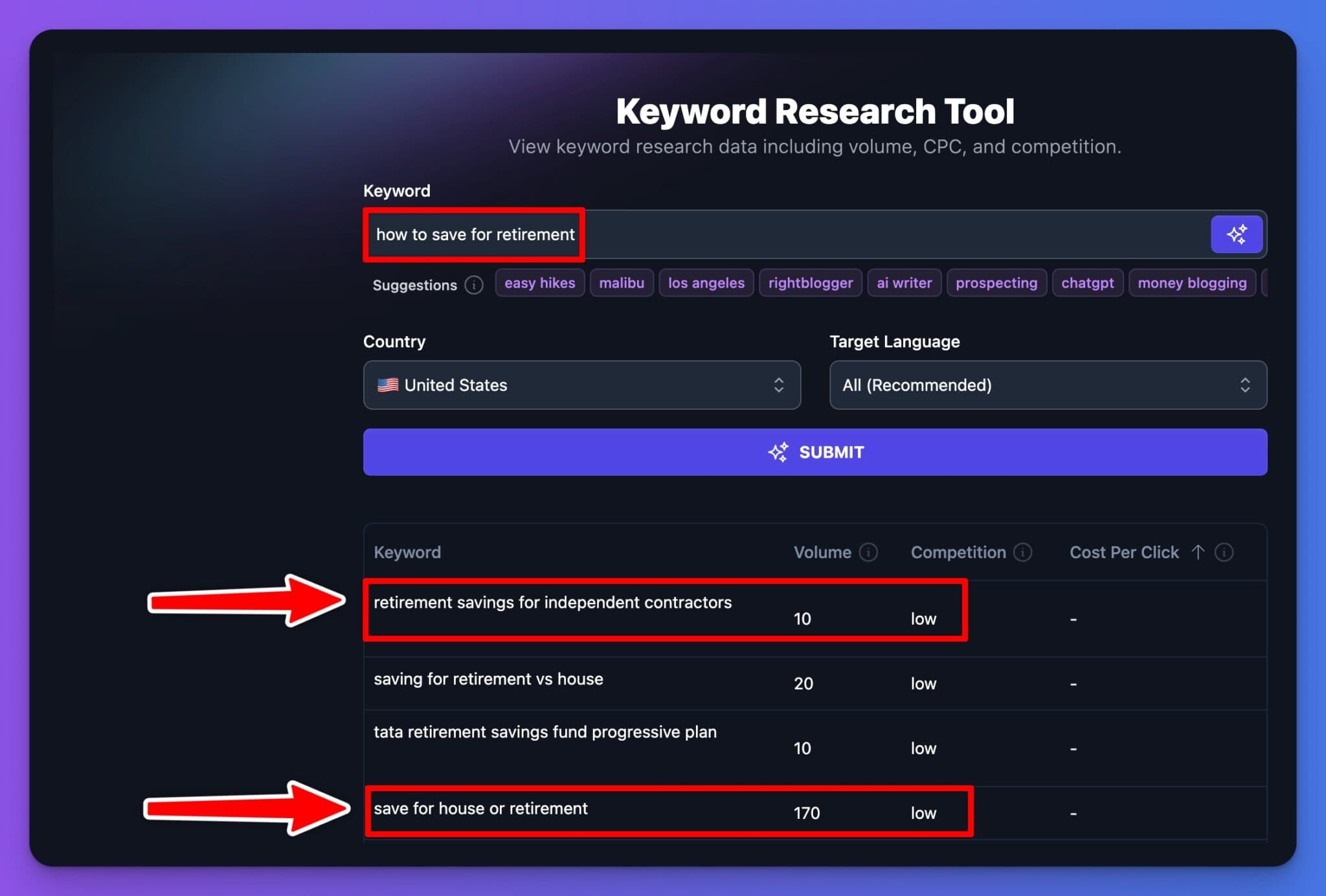Long-Tail Keywords: Get More Targeted Traffic & Conversions

Long-tail keywords may seem like a tiny detail in the vast universe of SEO-land, but I’ll be the first to tell you… they hold immense power for bloggers, creators, and business owners alike.
Targeting long-tail keywords is one of the most effective ways to get higher quality traffic, while fighting against fewer competitors.
Let’s look at an example of real long-tail keywords in the wild, with a very general keyword, “black running shoes” first and a more targeted, long-tail example second:
- black running shoes: 543,000,000 results
- black waterproof trail running shoes for men: 25,800,000 results

Now, I’m guessing you don’t sell black waterproof trail running shoes for men, but if you do, please drop me a line! 👋
So let’s bring this back down to earth for the rest of us non-Amazon or Nike employees.
Picture this: you’re a blogger pouring your heart and soul into crafting valuable content, but without the right keywords that your target audience is actually searching for, your voice might get lost in the digital noise. That’s where long-tail keywords swoop in to save the day.
Understanding the significance of long-tail keywords can be a game-changer for your online presence. These longer, more specific keyword phrases not only help you stand out in the crowded online space but also bring a targeted audience straight to your virtual doorstep. Imagine the impact of driving quality organic traffic that is genuinely interested in what you have to offer.
So, buckle up and get ready to unlock the true potential of your content with the magic of long-tail keywords.
Join RightBlogger and try our Article Writer tool to quickly whip up an SEO-optimized first draft of an article for any long-tail keyword phrase you’re pursuing.
Understanding Long-Tail Keywords
In the realm of search engine optimization (SEO), long-tail keywords play a pivotal role in enhancing the visibility and reach of your online content.
Why Long-Tail Keywords Matter More Than Ever in 2024
Long gone are the days where short, generic keywords ruled the search engine landscape. With the evolution of search engine algorithms and the ever-changing behaviors of online users, long-tail keywords have emerged as the stars of SEO strategies. These keywords, characterized by their specificity and detailed nature, cater to niche audiences and help websites rank higher on search engine result pages (SERPs).
The shift towards long-tail keywords reflects the search engines’ focus on delivering accurate and relevant results to users. By incorporating long-tail keywords into your content—and building out a keyword cluster of relevant long-tail terms—you can target specific search queries, attract motivated audiences, and ultimately drive more organic traffic to your website.
Differentiating Long-Tail Keywords from Short-Tail Keywords
Long-tail keywords are often longer phrases that are more specific and target a particular audience segment. In contrast, short-tail keywords are shorter, more general terms that have higher search volumes but also face higher competition. Knowing when to use each type effectively can significantly impact your SEO efforts.
- Short-tail keyword example: blogging
- Long-tail keyword example: personal finance blogging on a budget
When you’re aiming to reach a broad audience or for general brand awareness, short-tail keywords may be the move.
On the other hand, if you’re targeting a specific niche, offering detailed products or services, or looking to address a particular pain point, long-tail keywords are the way to go.
Focus more effort on smart long-tail keywords, but keep in mind that the key lies in striking a balance between the two and aligning your keyword strategy with your overall goals and target audience.
2 Benefits of Targeting Long-Tail Keywords
Long-tail keywords are a vital component of any successful SEO strategy, offering numerous advantages that can significantly impact your online visibility and engagement. From targeted traffic to cost-effective marketing, incorporating long-tail keywords can revolutionize your customer acquisition efforts.
1. Targeted Traffic and Higher Conversion Rates
Long-tail keywords play a crucial role in attracting qualified leads to your website.
By targeting specific phrases that align with users’ search intent, you can drive organic traffic from individuals actively seeking your products or services.
Research indicates that long-tail keywords have a higher conversion rate compared to generic terms. According to that study, long-tail keywords convert 2.5 times better than short-tail keywords, emphasizing their impact on driving quality leads and boosting conversion rates.
2. Lower Competition and Cost-Effective Marketing
One of the primary benefits of leveraging long-tail keywords is the reduced competition you’ll face in search engine results.
While short-tail keywords are highly competitive and often dominated by established brands, long-tail variations provide a niche opportunity to target specific audience segments effectively. This focused approach allows small businesses to compete with larger competitors on a level playing field, maximizing their visibility within their target market.
To identify valuable long-tail keywords without breaking the bank, consider utilizing budget-friendly keyword research tools like our very own supercharged Keyword Research Tool or Ryan’s Free Keyword Tool, which both offer valuable insights for free (and for unlimited use at a fraction of the cost of other tools).

Finding the Right Long-Tail Keywords
In the vast realm of digital content creation, one of the pivotal strategies for enhancing visibility and attracting the right audience is the effective utilization of long-tail keywords. These keyword phrases, though more specific and longer, play a crucial role in boosting your content’s search engine optimization (SEO) and driving targeted traffic to your website. Let’s delve into some practical methods to discover the perfect long-tail keywords to uplift your content game!
Utilizing Keyword Research Tools
To embark on the journey of long-tail keyword discovery, arming yourself with the right tools is essential. Popular keyword research tools like our very own Keyword Research Tool or Ryan’s Free Keyword Tool, can be powerful allies in your quest to unlocking long-tail opportunities.
Check out these two great long-tail keyword examples I found in 3 seconds with our free keyword tool:

These kinds of tools offer insights into search volumes, competition levels, and trend analysis, enabling you to pinpoint profitable long-tail keywords for your niche.
When using these tools, beginners should focus on simplicity. Start by entering broad terms related to your content and let the tools work their magic in suggesting relevant long-tail variations.
Pay attention to metrics like search volume and keyword difficulty to identify keywords with the right balance of traffic potential and competitiveness. Thankfully, you can use the sort functions on our tools to do that in a jiff.
Leveraging Google Autocomplete and Related Searches
In addition to sophisticated tools, don’t overlook the prowess of Google itself in unearthing valuable long-tail keyword ideas. Google’s Autocomplete feature, which anticipates search queries as you type, can spark inspiration for long-tail variations of popular terms.

Similarly, exploring the Related Searches section at the bottom of search result pages can unveil related topics and keywords that might align perfectly with your content.

Experimentation is key here. Play around with different search queries related to your niche and observe the autocomplete suggestions and related searches that pop up. This hands-on approach can lead you to unique long-tail keywords that cater specifically to your target audience’s search intents.
Remember, the right long-tail keywords can be the gateway to unlocking untapped organic traffic and connecting with your audience on a deeper level. Happy keyword hunting!
Implementing Long-Tail Keywords in Content
Implementing long-tail keywords effectively in your content can significantly boost your online visibility and attract the right audience to your website. Let’s dive into two essential strategies for seamlessly integrating long-tail keywords into your content.
Creating High-Quality and Relevant Content
Creating high-quality and relevant content is the backbone of any successful SEO strategy. When incorporating long-tail keywords, it’s crucial to focus on providing valuable information that addresses your audience’s needs. Consider the following tips to optimize your content:
- Understand Your Audience: Conduct thorough research to understand your target audience’s preferences, pain points, and interests. Tailor your content to resonate with them.
- Craft Engaging Posts: Write compelling and informative posts that not only incorporate long-tail keywords naturally but also keep your readers engaged throughout.
- Solve Problems: Use long-tail keywords to address specific problems or questions that your audience may have. Offer solutions and valuable insights in your content.
- Maintain Relevance: Ensure that your content remains relevant and up-to-date. Regularly update your posts to align with changing trends and search queries.
Nail these content writing best practices, and you’ll be in great shape.
Join RightBlogger and try our Article Writer tool to quickly whip up an SEO-optimized first draft of an article for any long-tail keyword phrase you’re pursuing.
Optimizing Meta Tags and Headers
Optimizing meta tags, headers, and titles with long-tail keywords is a vital part of on-page SEO. These elements play a crucial role in improving your search engine visibility and driving organic traffic. Here are some best practices:
- Meta Descriptions: Include as much of your keywords as possible, written naturally into your meta descriptions, and image alt text. This practice helps search engines understand the context of your content.
- Headers: Structure your content with headers (H1, H2, H3, etc.) that contain relevant terms to the topic at-hand. This not only enhances readability but also signals the importance of specific topics to search engines.
- Titles: Craft catchy and keyword-rich meta titles that entice users to click. Incorporate long-tail keywords strategically at the beginning of your titles for better SEO.
By implementing these strategies, you can optimize your content for both search engines and your target audience, driving organic traffic and increasing your online visibility.
Monitoring and Adapting Your Long-Tail Keyword Strategy
In the realm of SEO, staying vigilant and adaptive is key to long-term success. Monitoring and adapting your long-tail keyword strategy involves a combination of data analysis, trend awareness, and strategic adjustments to optimize your online presence. Let’s delve into two vital aspects of this continuous process.
Analyzing Metrics and Refining Your Approach
Understanding the metrics associated with your long-tail keywords is fundamental to refining your approach effectively. By delving into analytics data, you gain insights into which keywords are driving traffic, generating leads, and ultimately converting.
Tools like Google Analytics and Google Search Console can provide valuable data on your keyword performance over time.
- Are certain keywords consistently underperforming?
- Are there new opportunities emerging?
- Are there clear high-intent keyword clusters you can build out?
By asking these questions and proactively refining your strategy, you can enhance your SEO efforts and improve your website’s visibility.
Staying Updated with Industry Trends and Algorithm Changes

The digital marketing landscape is ever-evolving, with search engine algorithms frequently changing and industry trends shaping online behavior. To stay ahead of the curve, it’s crucial to stay informed about the latest developments in the SEO world.
Other websites like Moz and Search Engine Land also offer insightful articles, guides, and updates on algorithm changes.
By incorporating this knowledge into your strategy, you can adapt your longer-tail keywords to align with current trends and search engine preferences. Remember, staying stagnant in SEO means falling behind, so embrace the dynamic nature of the digital realm and evolve with it.
Long-Tail Keywords: Final Takeaways
Long-tail keywords aren’t just random words strung together; they are the secret sauce to unlocking targeted traffic and boosting your search engine visibility.
By tapping into the specific phrases your audience is searching for, you’re not only driving more qualified visitors to your site, but you’re also standing out in a sea of generic content.
So, why wait? Start sprinkling those more target terms into your content and watch your online presence soar. Remember, it’s not about being the loudest voice in the room; it’s about being the most relevant one.
Join RightBlogger and try our Article Writer tool to quickly whip up an SEO-optimized first draft of an article for any keyword phrase you’re aiming for. Plus we even have a tactic filled course for subscribers about SEO.
What is a long-tail keyword, and how long should it be?
A long-tail keyword is a longer, more specific search phrase that shows clear intent. It usually has 3 or more words, but the real test is how specific it is.
For example, “running shoes” is broad. “Black waterproof trail running shoes for men” is long-tail because it describes a very exact need.
Long-tail keywords often bring fewer visitors than big keywords, but those visitors are more likely to take action. They are also easier to rank for because there is less competition.
Why do long-tail keywords usually convert better than short keywords?
Long-tail keywords convert better because they match what someone really wants. When a search is specific, the person is often closer to buying, signing up, or solving a problem.
Short keywords can mean many things, so the traffic is less focused. A long-tail phrase helps you attract readers who are a better fit for your content or offer.
A simple rule: the more detail in the search, the stronger the intent. That is why long-tail keywords can lead to higher quality traffic and more conversions.
How do I find good long-tail keywords without expensive SEO tools?
Start with free options like Google Autocomplete and the “Related searches” section. Type a broad topic and write down the longer phrases Google suggests.
Next, use a keyword tool to quickly check ideas and compare them. The RightBlogger Keyword Generator can help you spot long-tail phrases and sort by difficulty and volume.
Pick keywords that match your audience’s exact question and your content’s goal. If you can answer the search better than what is already ranking, it is a strong keyword to target.
Where should I use long-tail keywords in a blog post for best SEO results?
Put your long-tail keyword in key places like the title, the first paragraph, and at least one heading. Use it in a natural way, like you would say it out loud.
Also add related terms in subheadings, image alt text, and your meta description. This helps search engines understand the full topic, not just one phrase.
Avoid stuffing the same keyword over and over. A few clear uses plus helpful content is usually enough to rank and keep readers engaged.
How can RightBlogger help me write and optimize content for long-tail keywords?
RightBlogger helps you turn a long-tail keyword into a strong draft fast, so you can publish more often without losing quality. You can use the RightBlogger AI Article Writer to create an SEO-focused first draft built around your keyword.
After you pick a main keyword, you can group related terms into a plan, so your site builds topical authority. The RightBlogger Keyword Clustering tool makes it easier to organize long-tail keywords into a clear content map.
This workflow saves time and helps you cover a topic fully, which is great for both rankings and reader trust. It also keeps your content focused on what people are actually searching for.
Article by Ryan Robinson
RightBlogger Co-Founder, Ryan Robinson teaches 500,000 monthly readers SEO and online business at ryrob.com. A recovering side project addict.
New:Autoblogging + Scheduling
Automated SEO Blog Posts That Work
Try RightBlogger for free, we know you'll love it.
- No Card Required
- Blog Posts in One Click
- Unlimited Usage





Leave a comment
You must be logged in to comment.
Loading comments...